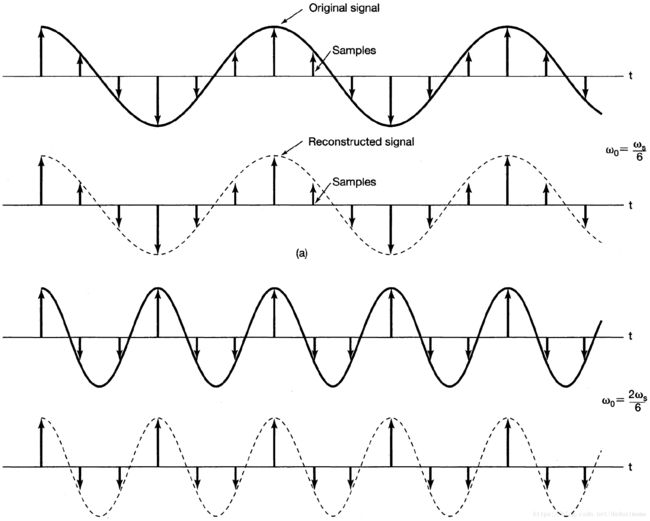信号的采样和奇妙的混叠(Aliasing) 贰
混叠频率的计算
上次我们讲到如果混叠没能成功避免,那么混叠后的信号就会偷偷混入重建后的信号。那么这个经过伪装的“伪装信号”的频率是多少呢?他会出现在频谱中的哪里呢?这是可以通过精确计算得到的。
先从奥本海姆的信号与系统中的一幅插图说起,奥本海姆老师想要通过这幅图说明混叠,所绘制的波形为下图公式所示的余弦函数。
图中的ωo表示原始信号的频率,ωs表示采样频率。这幅图一共有四张,前两张的采样频率分别是原始频率的6倍和3倍,所以重建后的信号并没有出现混叠如下图所示。
点击图像放大
由于我很喜欢这个例子,所以我就用matlab把它仿真了一下。此处我的余弦函数的采样频率为60Hz, 所以第一个连续信号(下图中第一行)的原始频率为10Hz, 此时采样频率为原始信号频率的6倍。第二个连续信号(下图中第三行)的原始频率为20Hz, 此时采样频率为原始信号频率的3倍。(箭头没能仿真成功,嘻嘻)
点击图像放大
Matlab代码如下:
%% sampling freqency 6 times continous signal
Fs = 60; % Sampling Freq.
Fo = Fs/6; % freq. of continous Signal
T = 1/Fs; % sampling period
tmin = -pi/15.7; % lower limit of time vector
tmax = pi/15.7; % upper limit of time vector
Bins = 400; % Number of Bins
t = linspace(tmin, tmax, Bins); % time space vector
nmin = ceil(tmin / T); % lower limit of num vector
nmax = floor(tmax / T); % upper limit of num vector
n = nmin:nmax; % discrete space vector
CosineSignal = cos(2.*pi.*Fo.*t);
SampleSignal = cos(2.*pi.*Fo.*n.*T);
subplot(4,1,1)
plot(t,CosineSignal,'k','LineWidth',2);
title('\fontsize{35}Sampling freqency 6 times continous signal. i.e. Proper sampling');
hold on
stem(n*T,SampleSignal,'r','filled','LineWidth',2)
hold off
subplot(4,1,2)
plot(t,CosineSignal,'--k','LineWidth',2);
title('\fontsize{35}Rebuild continous signal with sampled discrete signal');
hold on
stem(n*T,SampleSignal,'r','filled','LineWidth',2)
hold off
%% sampling freqency 3 times continous signal
Fs = 60; % Sampling Freq.
Fo = Fs/3; % freq. of continous Signal
T = 1/Fs; % sampling period
tmin = -pi/15.7; % lower limit of time vector
tmax = pi/15.7; % upper limit of time vector
Bins = 400; % Number of Bins
t = linspace(tmin, tmax, Bins); % time space vector
nmin = ceil(tmin / T); % lower limit of num vector
nmax = floor(tmax / T); % upper limit of num vector
n = nmin:nmax; % discrete space vector
CosineSignal = cos(2.*pi.*Fo.*t);
SampleSignal = cos(2.*pi.*Fo.*n.*T);
subplot(4,1,3)
plot(t,CosineSignal,'k','LineWidth',2);
title('\fontsize{35}Sampling freqency 3 times continous signal. i.e. Proper sampling');
hold on
stem(n*T,SampleSignal,'r','filled','LineWidth',2)
hold off
subplot(4,1,4)
plot(t,CosineSignal,'--k','LineWidth',2);
title('\fontsize{35}Rebuild continous signal with sampled discrete signal');
hold on
stem(n*T,SampleSignal,'r','filled','LineWidth',2)
hold off 在用matlab仿真时,重建信号(即图像中灰色虚线)的频率由于没有出现混叠。则在用matlab绘制图像时,重建的COS波形的频率沿用了原始信号的频率Fo。但在仿真下面图像时就必须要精确的计算出混叠后的频率Fs才能绘制出混叠信号的波形。
点击图像放大
要想画出上图中的虚线,即伪装后变慢了的信号,必须要精确的知道信号变慢了多少。对于欠采样不太严重的情况(即,原始频率小于采样频率但大于采样频率的一半。Fs/2 在本例中我所使用的采样频率为60Hz, 按照公式(c)和公式(d)则发生混叠后的混叠频率分别为: For (c) ωo = 40Hz ; Fa = ωs - ωo = 60 - 40 = 20Hz For (d) ωo = 50Hz ; Fa = ωs - ωo = 60 - 50 = 10Hz 如果原始信号的频率远远高于采样频率,即原始频率Fo不仅大于Fs还有可能大于Fs的2,3,4,5...倍则可以使用如下公式。fa表示混叠频率,fs表示采样频率,f表示原始信号的最高频。式中||表示求绝对值,式中(closest integermultiple of fs)表示整数倍于最接近原始频率f的倍数。例如,如果采样频率为100Hz,原始信号的最高频为710Hz则这是式中的(closest integermultiple of fs)等于7,即7*fs。 现假设信号采样频率为100 Hz,输入信号包含下列频率:25 Hz、70 Hz、160 Hz和510 Hz。 低于50 Hz奈奎斯特频率才可正确采样,超过50 Hz的频率显示为混叠,所以只有频率为25Hz的信号才能被正确采样。fs/2为奈奎斯特频率即采样频率的一半。 其中,频率超过50Hz的信号的混叠频率计算公式为: (1) 当输入信号的频率F2为70Hz时,采样频率Fs为100Hz。按照奈奎斯特采样定律,要想对70Hz的输入信号充分采样,采样频率至少要大于140Hz,即输入信号频率的两倍。所以发生了混叠,由于输入频率为70,所以离采样频率100最近的整数倍数是1(即,这里的(closest integermultiple of fs) = 1)。 计算结果如下: F2 Alias = |100 - 70| = 30Hz (2) 当输入信号的频率F3为160Hz时,采样频率为Fs100Hz。采样频率低于输入信号的频率,发生了混叠,由于输入频率为160,所以离采样频率100最近的整数倍数是2(即,这里的(closest integermultiple of fs) = 2)。 计算结果如下: F3 Alias = |2*100 - 160| = 40Hz (3) 当输入信号的频率F4为510Hz时,采样频率为Fs100Hz。采样频率低于输入信号的频率,发生了混叠,由于输入频率为510,所以离采样频率100最近的整数倍数是5(即,这里的(closest integermultiple of fs) = 5)。 计算结果如下: F4 Alias = |5*100 - 510| = 10Hz 混叠频率即折叠频率: 混叠频率有时又叫折叠频率,只需把超过奈奎斯特频率(Fs/2)的频段或是超过采样频率(Fs)的频段以奈奎斯特频率或采样频率为中轴对折过去就好了。或者说是以奈奎斯特频率或采样频率为中轴的镜像。如下图,一个6Hz的信号以奈奎斯特频率3.5Hz为中轴折叠为1Hz的信号。同理,一个8Hz的信号以采样频率7Hz为中轴折叠为频率为6Hz的信号。 好了, 计算公式以及详细的计算方法都已经给出来了。最后用Matlab把教科书中的带有混叠的那部分图示仿真出来(注意:重建后的混叠信号我用蓝色的虚线表示出来了)。 点击图像放大 Matlab代码: (全文完) 鸣谢: 【1】http://www.ni.com/white-paper/2709/zhs/ 美国国家仪器(NI) 技术白皮书 【2】signals and systems 第二版 奥本海姆 【3】Matlab 2017a 【4】http://e2e.ti.com/blogs_/archives/b/precisionhub/archive/2015/09/04/aliasing-in-adcs-not-all-signals-are-what-they-appear-to-be 德州仪器 谢谢收看! 再见! 《圣经》马太福音3章2节 天国近了,你们应当悔改! *配图与本文无关* %% sampling freqency 3/2 times continous signal
Fs = 60; % Sampling Freq.
Fo = 4*Fs/6; % freq. of continous Signal
T = 1/Fs; % sampling period
tmin = -pi/15.7; % lower limit of time vector
tmax = pi/15.7; % upper limit of time vector
Bins = 400; % Number of Bins
t = linspace(tmin, tmax, Bins); % time space vector
nmin = ceil(tmin / T); % lower limit of num vector
nmax = floor(tmax / T); % upper limit of num vector
n = nmin:nmax; % discrete space vector
CosineSignal = cos(2.*pi.*Fo.*t);
SampleSignal = cos(2.*pi.*Fo.*n.*T);
figure;
subplot(4,1,1)
plot(t,CosineSignal,'k','LineWidth',2);
title('\fontsize{35}Sampling freqency 1.5 times continous signal. Improper sampling resualt in Aliasing');
hold on
stem(n*T,SampleSignal,'r','filled','LineWidth',2)
hold off
%figure out Aliasing freq.
Fa = abs(Fo-Fs);
CosineSignal = cos(2.*pi.*Fa.*t);
subplot(4,1,2)
plot(t,CosineSignal,'--b','LineWidth',2);
title('\fontsize{35}Rebuild continous signal with sampled discrete signal');
hold on
stem(n*T,SampleSignal,'r','filled','LineWidth',2)
hold off
%% sampling freqency 6/5 times continous signal
Fs = 60; % Sampling Freq.
Fo = 5*Fs/6; % freq. of continous Signal
T = 1/Fs; % sampling period
tmin = -pi/15.7; % lower limit of time vector
tmax = pi/15.7; % upper limit of time vector
Bins = 400; % Number of Bins
t = linspace(tmin, tmax, Bins); % time space vector
nmin = ceil(tmin / T); % lower limit of num vector
nmax = floor(tmax / T); % upper limit of num vector
n = nmin:nmax; % discrete space vector
CosineSignal = cos(2.*pi.*Fo.*t);
SampleSignal = cos(2.*pi.*Fo.*n.*T);
subplot(4,1,3)
plot(t,CosineSignal,'k','LineWidth',2);
title('\fontsize{35}Sampling freqency 1.2 times continous signal. Improper sampling resualt in Aliasing');
hold on
stem(n*T,SampleSignal,'r','filled','LineWidth',2)
hold off
% figure out Aliasing freq.
Fa = abs(Fo-Fs);
CosineSignal = cos(2.*pi.*Fa.*t);
subplot(4,1,4)
plot(t,CosineSignal,'--b','LineWidth',2);
title('\fontsize{35}Rebuild continous signal with sampled discrete signal');
hold on
stem(n*T,SampleSignal,'r','filled','LineWidth',2)
hold off








